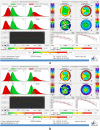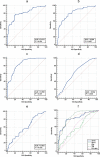Corneal biomechanics in normal and subclinical keratoconus eyes
- PMID: 37968616
- PMCID: PMC10647094
- DOI: 10.1186/s12886-023-03215-6
Corneal biomechanics in normal and subclinical keratoconus eyes
Abstract
Background: The diagnosis of keratoconus, as the most prevalent corneal ectatic disorder, at the subclinical stage gained great attention due to the increased acceptance of refractive surgeries. This study aimed to assess the pattern of the corneal biomechanical properties derived from Corneal Visualization Scheimpflug Technology (Corvis ST) and evaluate the diagnostic value of these parameters in distinguishing subclinical keratoconus (SKC) from normal eyes.
Methods: This prospective study was conducted on 73 SKC and 69 normal eyes. Subclinical keratoconus eyes were defined as corneas with no clinical evidence of keratoconus and suspicious topographic and tomographic features. Following a complete ophthalmic examination, topographic and tomographic corneal assessment via Pentacam HR, and corneal biomechanical evaluation utilizing Corvis ST were done.
Results: Subclinical keratoconus eyes presented significantly higher Deformation Amplitude (DA) ratio, Tomographic Biomechanical Index (TBI), and Corvis Biomechanical Index (CBI) rates than the control group. Conversely, Ambrósio Relational Thickness to the Horizontal profile (ARTh), and Stiffness Parameter at the first Applanation (SPA1) showed significantly lower rates in SKC eyes. In diagnosing SKC from normal eyes, TBI (AUC: 0.858, Cut-off value: > 0.33, Youden index: 0.55), ARTh (AUC: 0.813, Cut-off value: ≤ 488.1, Youden index: 0.58), and CBI (AUC: 0.804, Cut-off value: > 0.47, Youden index: 0.49) appeared as good indicators.
Conclusions: TBI, CBI, and ARTh parameters could be valuable in distinguishing SKC eyes from normal ones.
Keywords: Corneal biomechanics; Corvis ST; Scheimpflug technology; Subclinical keratoconus.
© 2023. The Author(s).
Conflict of interest statement
The authors declare no competing interests.
Figures



References
-
- Salomão M, Hoffling-Lima AL, Lopes B, Belin MW, Sena N, Dawson DG, et al. Recent developments in keratoconus diagnosis. Expert Rev Ophthalmol. 2018;13(6):329–341. doi: 10.1080/17469899.2018.1555036. - DOI
MeSH terms
Grants and funding
LinkOut - more resources
Full Text Sources

